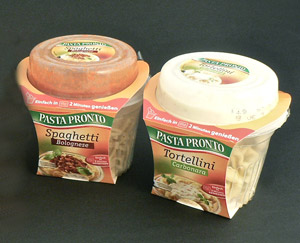RPC BEBO PLASTIK
Two-part container adds convenience to “Pasta Pronto” meals
 The new “Pasta Pronto” range of microwave meals are thermoformed in high transparency PP (Photo: RPC Bebo Plastik) |
RPC Bebo Plastik (Bremervörde / Germany; www.rpc-containers.co.uk) has manufactured an innovative two-part container for the new “Pasta Pronto” brand, developed by food manufacturer Buss (Ottersberg / Germany), which delivers a fresh pasta and sauce combination that is ready to eat within minutes.
Buss required an unusual design that would keep two containers – which separately contain the pasta and sauce – together on shelves. RPC Bebo Plastik’s solution is a tall container which holds 300g of pasta, with a smaller round sauce pot that sits upside-down on top of the cup holding the pasta. Both packs are thermoformed in high transparency PP, and bring a shelf life of around three weeks for the food. A cardboard outer sleeve holds the two containers together. Manfred Petersen, Buss general manager, said: “The advantage of separating sauce and pasta into two containers is the possibility to individually cook ingredients to the optimum point in the factory. The pasta is ‘al dente,’ while the sauces are prepared to bring out their rich flavours.” Before heating the sauce is poured from the smaller container on top of the pasta into the larger cup. The consumer then places this in the microwave for two minutes to cook. The container includes ribbed insulation that protects the consumer’s fingers from being burnt after heating, so the meal can be eaten directly from the cup.
Buss required an unusual design that would keep two containers – which separately contain the pasta and sauce – together on shelves. RPC Bebo Plastik’s solution is a tall container which holds 300g of pasta, with a smaller round sauce pot that sits upside-down on top of the cup holding the pasta. Both packs are thermoformed in high transparency PP, and bring a shelf life of around three weeks for the food. A cardboard outer sleeve holds the two containers together. Manfred Petersen, Buss general manager, said: “The advantage of separating sauce and pasta into two containers is the possibility to individually cook ingredients to the optimum point in the factory. The pasta is ‘al dente,’ while the sauces are prepared to bring out their rich flavours.” Before heating the sauce is poured from the smaller container on top of the pasta into the larger cup. The consumer then places this in the microwave for two minutes to cook. The container includes ribbed insulation that protects the consumer’s fingers from being burnt after heating, so the meal can be eaten directly from the cup.
05.11.2010 Plasteurope.com [217680-0]
Published on 05.11.2010
